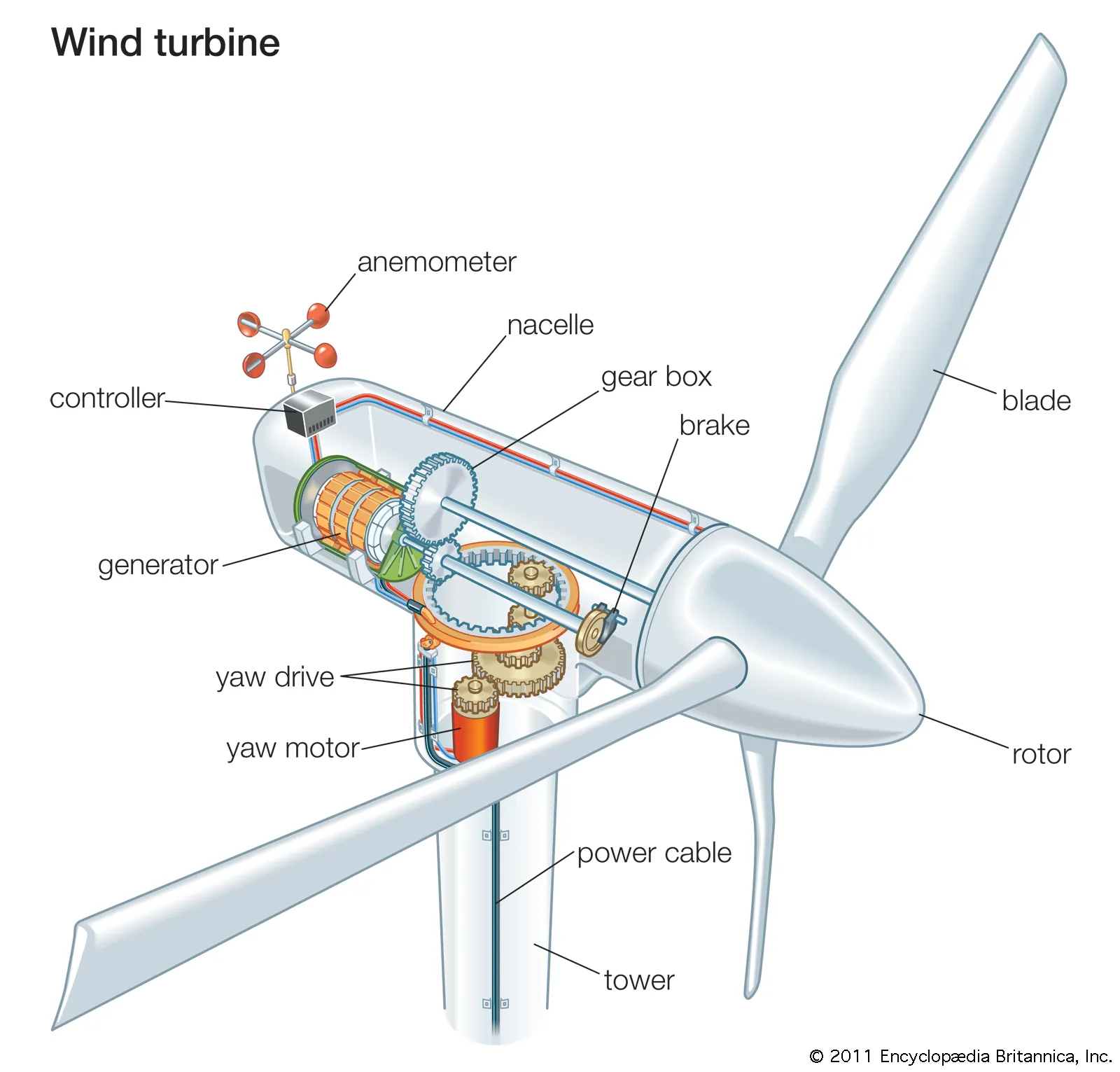Başlıklar
Introduction: Harnessing the Wind’s Power
Wind turbines, those majestic symbols of green energy, dot landscapes across the globe, turning air currents into electricity that powers our homes, businesses, and industries. At the heart of these technological marvels are numerous components, each playing a pivotal role in the turbine’s operation. Among these, friction discs might not capture the headlines, but their contribution is essential, ensuring that turbines operate smoothly and safely, day in and day out.
Understanding Wind Turbines: The Basics
Before diving into the specifics of friction discs, it’s crucial to grasp the fundamental workings of a wind turbine. Essentially, these devices convert the kinetic energy from wind into mechanical power. This conversion process involves several key components: the rotor blades that catch the wind, the shaft that rotates with the blades, and the generator that transforms the rotational motion into electricity. Managing this power—especially in terms of controlling the turbine’s speed and ensuring safe operation under varying wind conditions—requires precise mechanisms, where friction discs come into play.

The Crucial Role of Friction Discs
Friction discs are integral to the braking system of a wind turbine, providing the necessary resistance to slow down or halt the rotor’s motion. This capability is vital for both regular operations, such as adjusting the turbine’s speed to optimize energy production, and emergency situations, where stopping the turbine to prevent damage or accidents is paramount.
Technical Deep Dive
Understanding the technical operation of friction discs in wind turbines requires a dive into the mechanics of braking systems. Friction discs are integral to what is known as the turbine’s brake assembly, which plays a critical role in controlling the rotor speed and ensuring the system can be safely halted for maintenance or during excessively high wind speeds to prevent damage.
When the wind turbine’s control system signals a need to reduce rotor speed or to stop the rotor entirely, the brake system activates. This activation involves the mechanical application of the friction discs against a rotor disc or drum connected to the turbine’s shaft. The friction generated between the stationary friction discs and the rotating disc converts the kinetic energy of the turbine’s motion into heat, effectively slowing down or stopping the rotor’s spin.
This process is carefully controlled and calibrated to ensure smooth operation, prevent excessive wear on the discs, and avoid generating too much heat, which could damage the brake system or other components of the turbine. The materials of the friction discs are chosen for their ability to withstand the high temperatures and pressures involved in this process, as well as their durability over many cycles of operation.
In modern turbines, the efficiency and reliability of this system are enhanced through advanced materials and designs, as well as integration with the turbine’s overall control system to ensure timely and precise braking actions. This integration often includes sensors that monitor the condition of the friction discs and other brake system components, providing data that can be used for predictive maintenance to replace parts before they fail.
Types of Friction Discs
Wind turbines utilize various types of friction discs, each selected based on specific criteria like durability, heat resistance, and performance under different environmental conditions. The most common types include:
- Carbon-Carbon Composites: Known for their high-temperature tolerance and minimal wear.
- Sintered Metals: Valued for their robustness and reliable performance in harsh settings.
Why Material Matters
The choice of material for friction discs is not arbitrary. It’s a decision that impacts the turbine’s overall efficiency, maintenance needs, and lifespan. For instance, carbon-carbon composite discs, while more expensive, offer longer service life and better performance, reducing the frequency and costs of maintenance.
Innovations in Friction Disc Technology
The wind energy sector is no stranger to innovation, and friction disc technology is no exception. Recent advancements have led to the development of discs that are not only more durable and efficient but also more environmentally friendly. These innovations include improvements in material science, manufacturing processes, and design optimizations that enhance the discs’ functionality and sustainability.
The Environmental Angle
Sustainability is a cornerstone of the wind energy industry, and friction disc technology aligns with this principle through the use of eco-friendly materials and production methods. The aim is to minimize the environmental impact of these components throughout their lifecycle, from manufacturing to disposal.
Installation and Maintenance: Key to Longevity
Proper installation and diligent maintenance are critical for maximizing the performance and lifespan of friction discs in wind turbines. These processes ensure that the turbines remain efficient, safe, and operational, even under varying and sometimes extreme environmental conditions.
Best Practices for Installation
The installation of friction discs involves precision and attention to detail. Technicians must ensure that the discs are perfectly aligned and calibrated according to the turbine’s specifications. This precision helps in avoiding premature wear and tear and optimizes the braking system’s performance.
Maintenance: Ensuring Continuous Efficiency
Regular maintenance is crucial for the longevity of friction discs. This includes routine inspections for wear and damage, cleaning to remove any debris or contaminants, and timely replacement of the discs when necessary. Proper maintenance not only extends the life of the discs but also maintains the turbine’s overall efficiency and safety.
Troubleshooting Common Issues
Despite best efforts in maintenance, issues can arise. Common problems include uneven wear, which can affect braking performance, and contamination from oil or other substances, which can reduce friction and effectiveness. Identifying these issues early through regular checks allows for swift corrective measures, ensuring minimal downtime for the turbine.
Future Trends: Shaping the Wind Energy Landscape
The future of friction disc technology is closely tied to the evolution of wind turbines themselves. As turbines become larger and more powerful, the demands on friction discs will increase, driving further innovations in materials, design, and functionality.
Smart Technology Integration
One of the most exciting trends is the integration of smart technologies with friction disc systems. Sensors and IoT (Internet of Things) devices can monitor the condition of friction discs in real-time, predicting wear and scheduling maintenance proactively. This not only enhances the efficiency and safety of turbines but also reduces operational costs.
Advancements in Materials
The quest for materials that offer superior performance while being environmentally sustainable continues. Future friction discs may feature advanced composites or nano-materials, offering unprecedented levels of durability, heat resistance, and overall performance.
Conclusion: The Unsung Heroes
Friction discs may not be the most visible components of wind turbines, but they are certainly among the most critical for their operation and safety. Through continuous innovation and a focus on sustainability, the technology behind these essential parts is helping to ensure that wind energy remains a key player in the global transition to renewable energy sources.
FAQs
- How do friction discs contribute to wind turbine safety? Friction discs are crucial for safely controlling the rotor speed and stopping the turbine during maintenance or extreme weather conditions, preventing damage and ensuring the safety of the structure.
- What are the benefits of carbon-carbon composite friction discs? Carbon-carbon composite discs offer superior heat resistance, durability, and a lower wear rate, making them ideal for high-performance applications in wind turbines.
- Can the materials used for friction discs impact the environment? Yes, the production and disposal of friction disc materials can impact the environment, driving the need for sustainable materials and eco-friendly manufacturing processes.
- What future innovations are expected in friction disc technology for wind turbines? Future innovations may include the development of lighter, more durable materials, the integration of smart sensors for performance monitoring, and advancements in eco-friendly manufacturing practices.
- How does regular maintenance affect the lifespan of friction discs in wind turbines? Regular maintenance, including inspections and timely replacements, is essential to ensure the longevity of friction discs, preventing premature wear and extending the operational lifespan of wind turbines.
- How do smart technologies improve the maintenance of friction discs? Smart technologies enable real-time monitoring of friction discs, allowing for predictive maintenance and reducing unexpected downtime.
- Can the installation process affect the lifespan of friction discs? Yes, proper installation is crucial to prevent misalignment or imbalance, which can lead to uneven wear and reduce the lifespan of friction discs.

